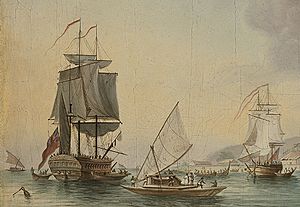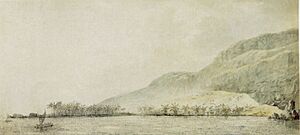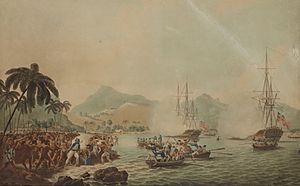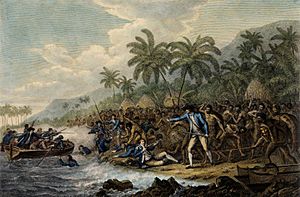Death of James Cook facts for kids

Resolution and Discovery (detail) by John Cleveley the Younger
|
|
| Date | 14 February 1779 |
|---|---|
| Location | Kealakekua Bay, Hawaii |
| Cause | Stabbed while attempting to hold the Hawaiian Chief for the return of a stolen boat. |
| Participants | Kalaniʻōpuʻu, Captain James Cook |
| Deaths | Dozens (including Cook) |
On February 14, 1779, Captain James Cook, a famous English explorer, faced a tragic end. He tried to take Kalaniʻōpuʻu, the powerful chief of Hawaii Island, with him. Cook hoped this would make the Hawaiians return a stolen boat. This decision was a big mistake and led to his death at Kealakekua Bay.
Cook's visits to Hawaii eventually led to many Europeans and Americans moving to the islands. This later caused big changes in the Hawaiian leadership, starting in 1893.
Contents
Captain Cook's Final Voyage
James Cook led three important trips to map parts of the world. On his third and last voyage, he discovered the islands we now call Hawaii. He first saw them on January 18, 1778. He stopped near Waimea on Kauai island. There, he met the local people to trade for food and water.
On February 2, 1778, Cook sailed on to North America and Alaska. He spent about nine months mapping the coast. He was also looking for a Northwest Passage, a sea route to the Atlantic Ocean.
Returning to Hawaii
Cook returned to the Hawaiian islands in January 1779 to get more supplies. He explored the coasts of Maui and Hawaii Island. Then, he anchored his ships, HMS Resolution and HMS Discovery, in Kealakekua Bay.
At first, Cook and his crew were welcomed. Their arrival happened during Makahiki, a special Hawaiian festival. This festival honored the god Lono and celebrated the yearly harvest. Some people thought the Hawaiians believed Cook was the god Lono. However, this idea is now thought to be incorrect.
After Cook's ships left the islands, the Makahiki festival ended. The season for battle and war began, honoring Kūkaʻilimoku, the god of war. By the time Cook returned, the local people were less friendly towards him and his men.
Growing Tensions
During his first visit, Cook tried to trade with the Hawaiians. He also ordered his men to take wood from a sacred burial ground called a "Morai." This wood was used to border the area where important people were buried and gods were shown. A crew member named John Ledyard wrote that Cook offered iron tools for the wood. When the chiefs refused, Cook ordered his men to take the wood anyway.
Ledyard also wrote about another incident. Captain Charles Clerke accused a Hawaiian chief of stealing a small boat from the Resolution. The boat was soon found, but the chief was very upset by the accusation. After 19 days, Cook and his ships left the bay.
On February 6, Cook's ships sailed out of Kealakekua Bay. But they soon met a strong storm. The storm damaged the main mast of the Resolution. So, on February 11, the Resolution had to return to Kealakekua Bay for repairs.
While the Resolution was anchored, one of its two large boats, called a longboat, was stolen by the Hawaiians. This was a serious loss. To get the boat back, Cook decided to try and take Kalaniʻōpuʻu, the island's chief, with him. Cook made some difficult decisions at this time.
Attempt to Take the Chief
On the morning of February 14, 1779, Cook and a group of armed marines went ashore. They went straight to the chief's home where Kalaniʻōpuʻu was sleeping. They woke him and asked him to come with them. Cook held the chief's hand as they walked towards the beach.
Kalaniʻōpuʻu's wife, Kānekapōlei, saw them leaving and called out to her husband. He did not stop. She then called to other chiefs and the townspeople. Two chiefs, Kanaʻina and Nuaa, followed the group. The king's wife followed behind, begging her husband to stop.
When they reached the beach, Kalaniʻōpuʻu's two youngest sons started to get into the boats. They thought they were invited to visit the ship again. Kānekapōlei shouted at them to get out of the boat. She also begged her husband to stop. At this point, the chief realized Cook was not inviting him, but trying to hold him against his will. He stopped and sat down.
Captain Cook's Death
An elderly Hawaiian priest, called a kahuna, approached Cook's men on the beach. He held a coconut and chanted. The men told him to go away, but he kept coming, singing a traditional Hawaiian song called a mele.
When Cook and his men looked away from the priest, they saw that thousands of Native Hawaiians had gathered on the beach. Cook told Kalaniʻōpuʻu to stand up, but the chief refused. As the crowd grew, Cook and his men began to back away, raising their guns. The two chiefs and Kānekapōlei stood in front of the chief, protecting him.
Kanaʻina, one of the chiefs, angrily approached Cook. Cook hit the chief with the flat side of his sword. Kanaʻina then grabbed Cook. Some say Kanaʻina did not mean to hurt Cook, while others say he hit Cook on the head with his leiomano, a shark-tooth weapon. Either way, Kanaʻina pushed Cook, who fell to the sand. As Cook tried to get up, Nuaa attacked him. Nuaa fatally stabbed Cook in the chest with a metal dagger. This dagger had been traded from Cook's ship earlier. Cook fell into the water.
This led to a violent fight between the Hawaiians and Cook's men. Four Royal Marines were killed, and two were wounded. The remaining sailors and marines were greatly outnumbered. They kept firing as they retreated to their small boat and rowed back to their ship. They killed several Hawaiians on the beach, possibly including High Chief Kanaʻina.
Cook's ships did not leave Kealakekua Bay until February 22. They stayed for another week to finish repairing the mast and to get better drinking water.
A young William Bligh, who later became the captain of HMS Bounty, claimed he watched from the Resolution with a spyglass. He said he saw Cook's body dragged up the hill and torn apart by the Native Hawaiians.
See also
- Death of Cook, several paintings





